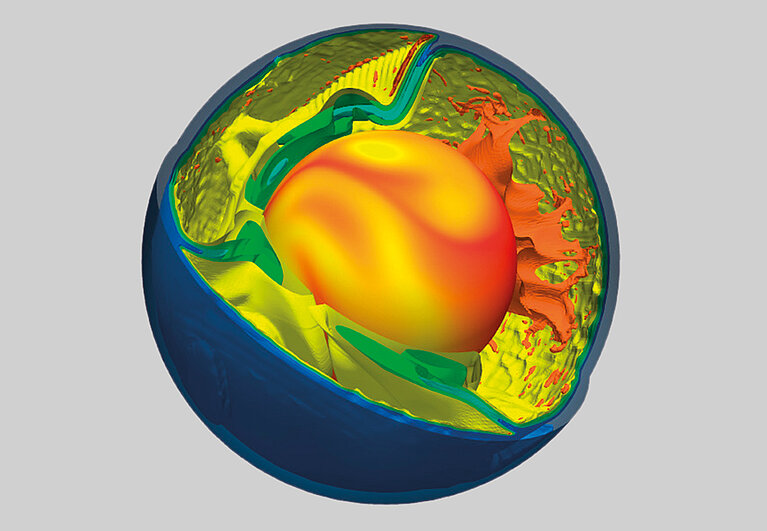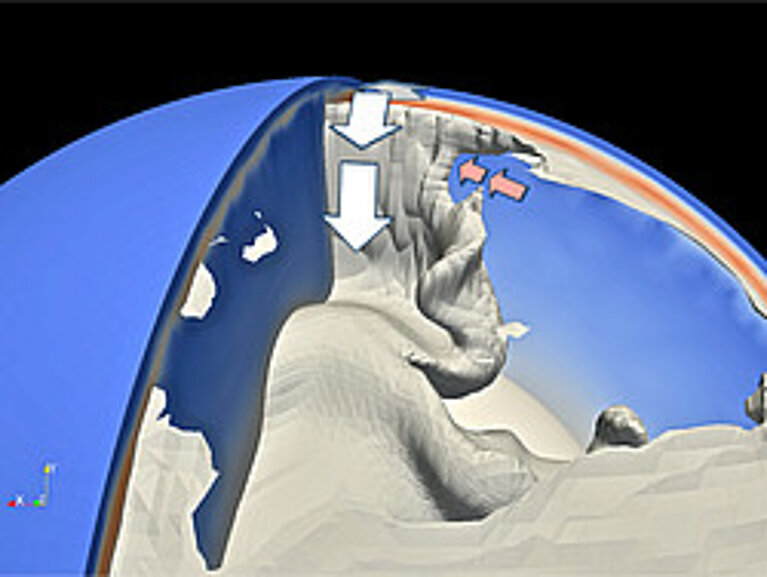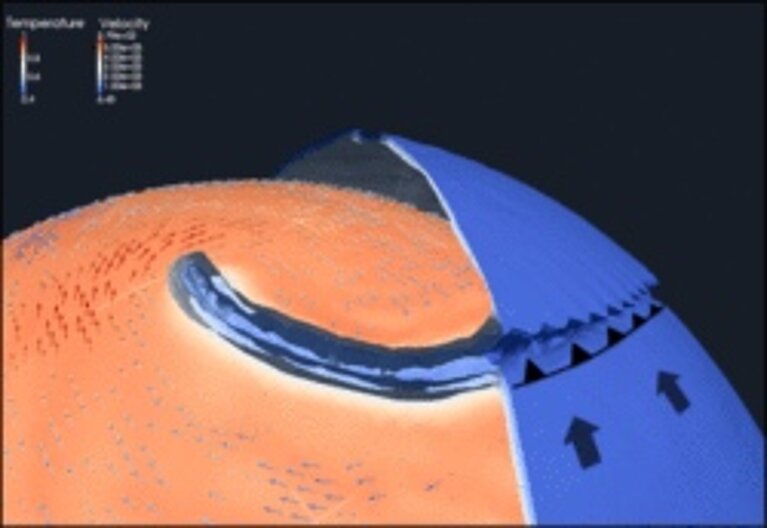February 23, 2012 - by Simone Ulmer
The Earth is probably the only planet in our solar system with active plate tectonics: the continental and oceanic plates move atop the Earth’s mantle. New plate forms continuously at a mid-oceanic ridge, allowing an ocean basin to grow until the plate is old and heavy enough to sink under the adjacent continental margins. The oceanic plate pushes itself under the continental crust at active continental margins known as subduction zones, and older oceanic plate does so under younger oceanic plate at island arcs. If the plates become snagged together and then abruptly slide forward again, there is an earthquake. Like the mid-oceanic ridges and volcanoes, subduction zones result from processes mainly occurring deep in the Earth’s interior. In the past four decades, computer simulations have contributed considerably to an understanding of these processes.
The models did not correspond to reality
Based on observation data, models are only an approximation to reality. Until now, scientists were unsuccessful in realistically simulating plates subducting into the Earth’s mantle in global models. In previous simulations, both plates sank vertically down into the Earth’s mantle together instead of one plate sliding obliquely under the adjacent plate.
ETH Zurich scientists have now succeeded for the first time in using global computer models to model an asymmetrical subduction of only one plate under the adjacent plate. The modelling was calculated on the “Monte Rosa” supercomputer belonging to the CSCS, Switzerland’s National Supercomputing Centre, and the “Brutus” cluster at ETH Zurich. Thanks to the simulation, the researchers were able to gain new insights into the Earth’s interior.
The boundary conditions of previous simulation models specify that the plates can move horizontally but not vertically, and thus there is no topography at all along the overthrust. However, the reality looks different: deep oceanic trenches up to more than 11 kilometres deep form along subduction zones. Thus the topography of the subducting oceanic plate is anything but flat. In his doctoral thesis with ETH Zurich Professor Paul Tackley and in collaboration with his colleagues, Fabio Crameri has now developed a simulation model in which the plates can move not only horizontally but also vertically – as in reality. The trick: Crameri used a viscous “layer of air” which he positioned over the surface of the crust in the simulation. He says “This layer of air is soft and has almost no density.” It must be viscous like the Earth’s mantle so it does not simply flow away during a time increment of several thousand years in the simulation of a plate overthrust.
The scientists started runs of the global model with and without this layer of air. After a period of about 10 million years, which is short on a geological timescale, an asymmetrical unilateral subduction had already developed in the model with the layer of air. The model realistically replicates the deformation experienced by the subducting plate in this process, and the formation of the deep oceanic trench.
Soft crust as lubricant
These simulations show conclusively for the first time why always just one plate sinks into the Earth’s mantle during subduction instead of both. When plates slide over one another, the rock is severely stressed by friction, pressure and temperature, but water carried by oceanic crust may reduce this. When the scientists superimposed a soft, water-rich layer of rock on the surface of the crust in addition to the air layer in their models, the simulation generated an even more stable unilateral subduction. This layer of rock is a kind of lubricant between the two plates. It ensures that the plates remain stable and slide over one another continuously without the subducting plate breaking off in the process.
In a three-dimensional simulation, the researchers were also able to show how the viscous Earth’s mantle circulates around the obliquely subducting plate. According to this, the plate rests on top of the mantle and forces the viscous mantle rock under the plate at the front edge. Crameri says “The mantle moves around the subducting plates and deforms them.”
Subducting crustal plates affect the dynamics of the Earth’s mantle. This is why models of this kind are very important in understanding the processes in the Earth’s interior to the beginning of plate tectonics on the Earth. However, they help towards a better understanding not only of plate tectonic processes but also of the associated earthquakes or volcanic activity. This is why such simulations are essential for hazard and risk assessment.
Interview with Fabrio Crameri about his research work
Reference
Crameri F, Tackley PJ, Meilick I, Gerya TV & Kaus BJP: A free plate surface and weak oceanic crust produce single-sided subduction on Earth, Geoph. Res. Letters (2012), 39, L03306, doi:10.1029/2011GL050046


